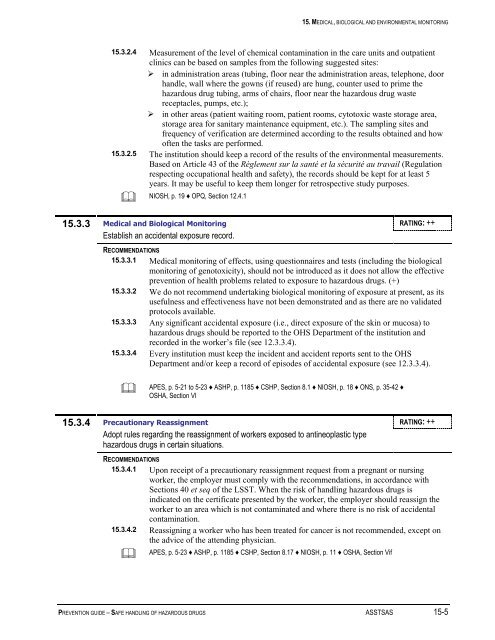Prevention Guide - Safe Handling of Hazardous Drugs - Irsst
Prevention Guide - Safe Handling of Hazardous Drugs - Irsst
Prevention Guide - Safe Handling of Hazardous Drugs - Irsst
You also want an ePaper? Increase the reach of your titles
YUMPU automatically turns print PDFs into web optimized ePapers that Google loves.
15. MEDICAL, BIOLOGICAL AND ENVIRONMENTAL MONITORING<br />
15.3.2.4 Measurement <strong>of</strong> the level <strong>of</strong> chemical contamination in the care units and outpatient<br />
clinics can be based on samples from the following suggested sites:<br />
‣ in administration areas (tubing, floor near the administration areas, telephone, door<br />
handle, wall where the gowns (if reused) are hung, counter used to prime the<br />
hazardous drug tubing, arms <strong>of</strong> chairs, floor near the hazardous drug waste<br />
receptacles, pumps, etc.);<br />
‣ in other areas (patient waiting room, patient rooms, cytotoxic waste storage area,<br />
storage area for sanitary maintenance equipment, etc.). The sampling sites and<br />
frequency <strong>of</strong> verification are determined according to the results obtained and how<br />
<strong>of</strong>ten the tasks are performed.<br />
15.3.2.5 The institution should keep a record <strong>of</strong> the results <strong>of</strong> the environmental measurements.<br />
Based on Article 43 <strong>of</strong> the Règlement sur la santé et la sécurité au travail (Regulation<br />
respecting occupational health and safety), the records should be kept for at least 5<br />
years. It may be useful to keep them longer for retrospective study purposes.<br />
<br />
NIOSH, p. 19 ♦ OPQ, Section 12.4.1<br />
15.3.3 Medical and Biological Monitoring RATING: ++<br />
Establish an accidental exposure record.<br />
RECOMMENDATIONS<br />
15.3.3.1 Medical monitoring <strong>of</strong> effects, using questionnaires and tests (including the biological<br />
monitoring <strong>of</strong> genotoxicity), should not be introduced as it does not allow the effective<br />
prevention <strong>of</strong> health problems related to exposure to hazardous drugs. (+)<br />
15.3.3.2 We do not recommend undertaking biological monitoring <strong>of</strong> exposure at present, as its<br />
usefulness and effectiveness have not been demonstrated and as there are no validated<br />
protocols available.<br />
15.3.3.3 Any significant accidental exposure (i.e., direct exposure <strong>of</strong> the skin or mucosa) to<br />
hazardous drugs should be reported to the OHS Department <strong>of</strong> the institution and<br />
recorded in the worker’s file (see 12.3.3.4).<br />
15.3.3.4 Every institution must keep the incident and accident reports sent to the OHS<br />
Department and/or keep a record <strong>of</strong> episodes <strong>of</strong> accidental exposure (see 12.3.3.4).<br />
<br />
APES, p. 5-21 to 5-23 ♦ ASHP, p. 1185 ♦ CSHP, Section 8.1 ♦ NIOSH, p. 18 ♦ ONS, p. 35-42 ♦<br />
OSHA, Section VI<br />
15.3.4 Precautionary Reassignment RATING: ++<br />
Adopt rules regarding the reassignment <strong>of</strong> workers exposed to antineoplastic type<br />
hazardous drugs in certain situations.<br />
RECOMMENDATIONS<br />
15.3.4.1 Upon receipt <strong>of</strong> a precautionary reassignment request from a pregnant or nursing<br />
worker, the employer must comply with the recommendations, in accordance with<br />
Sections 40 et seq <strong>of</strong> the LSST. When the risk <strong>of</strong> handling hazardous drugs is<br />
indicated on the certificate presented by the worker, the employer should reassign the<br />
worker to an area which is not contaminated and where there is no risk <strong>of</strong> accidental<br />
contamination.<br />
15.3.4.2 Reassigning a worker who has been treated for cancer is not recommended, except on<br />
the advice <strong>of</strong> the attending physician.<br />
<br />
APES, p. 5-23 ♦ ASHP, p. 1185 ♦ CSHP, Section 8.17 ♦ NIOSH, p. 11 ♦ OSHA, Section Vif<br />
PREVENTION GUIDE – SAFE HANDLING OF HAZARDOUS DRUGS ASSTSAS 15-5

















